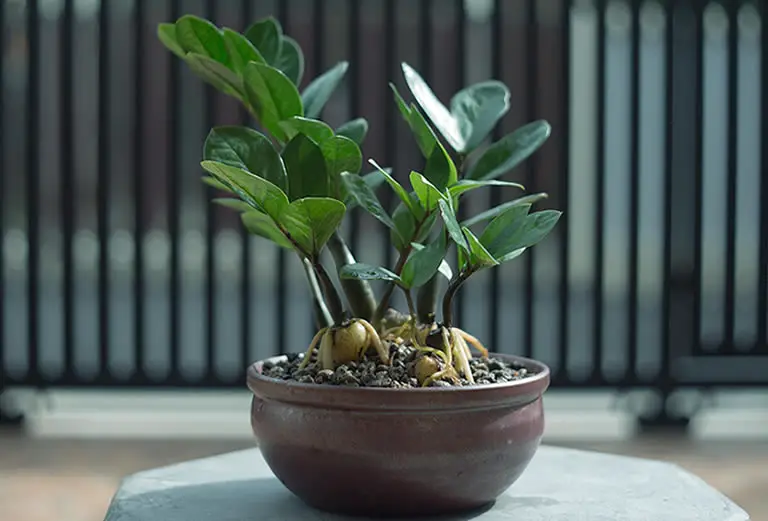In the realm of houseplants, few contenders boast the resilience, elegance, and air-purifying prowess quite like the ZZ Plant, a green sentinel in the world of indoor gardening. Also known as Zamioculcas zamiifolia, the ZZ Plant has earned its stripes as a favorite among plant enthusiasts and novices alike, thanks to its adaptability and low-maintenance nature.
Table of Contents
ZZ Plant Basics
Below is a brief introduction to the zz plant.
If you are not interested in learning more about the origins of this succiulent5 plant or its different varieties you can use the table of contents to jump ahead to the care guide.
ZZ plant origins
Hailing from the arid regions of Eastern Africa, specifically Zanzibar, and thriving in the shadowy depths of the underbrush, this botanical marvel has transcended its native landscapes to become a staple in homes and offices around the globe.
Whether you call it the ZZ Plant, Zanzibar Gem, or Eternity Plant, this hardy specimen has become a go-to choice for those seeking a touch of greenery without the burden of constant attention.
As we delve into the intriguing world of the ZZ Plant, we’ll uncover its hidden charms, explore its unique features, and unlock the secrets behind its ability to flourish in environments where other plants might wither.
ZZ plant varieties
In the diverse family of ZZ Plants, one variant that has recently taken the spotlight is the Raven ZZ Plant (Zamioculcas zamiifolia ‘Raven’).
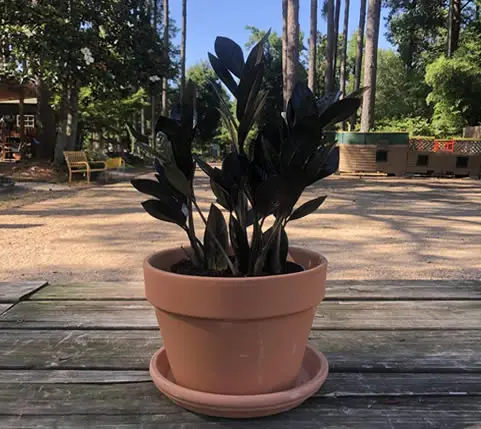
With its striking, dark foliage that seems to absorb and reflect light in a mesmerizing dance, the Raven ZZ Plant has become a coveted choice for interior décor enthusiasts.
The deep, almost ebony leaves of this cultivar add a touch of drama to any space, transforming the classic ZZ Plant into a contemporary and sophisticated houseplant.
Its resilience matches that of its green counterpart, making it a perfect choice for those looking to make a bold statement in their indoor greenery collection.
Beyond the Raven ZZ, the world of ZZ Plants unfolds with a variety of intriguing cultivars.
The ZZ Zanzibar Gem, known for its glossy, elliptical leaflets, showcases the plant’s ability to adapt to low-light conditions.
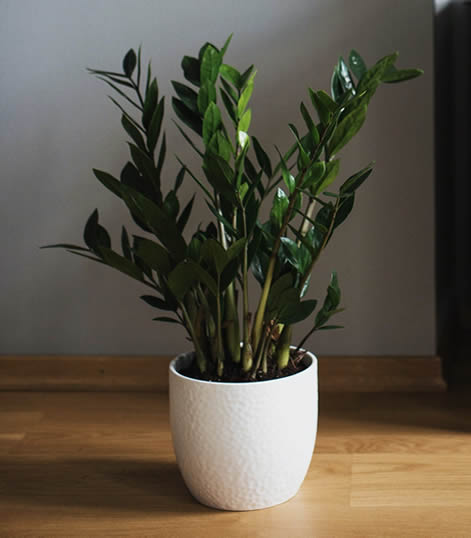
The ZZ Zenzi, a more compact version, is perfect for smaller spaces, while the ZZ Zamicro adds a touch of delicacy with its petite stature.
Each variety brings a unique flair to the ZZ family, and enthusiasts can select from an array of shapes, sizes, and shades to suit their individual aesthetic preferences.
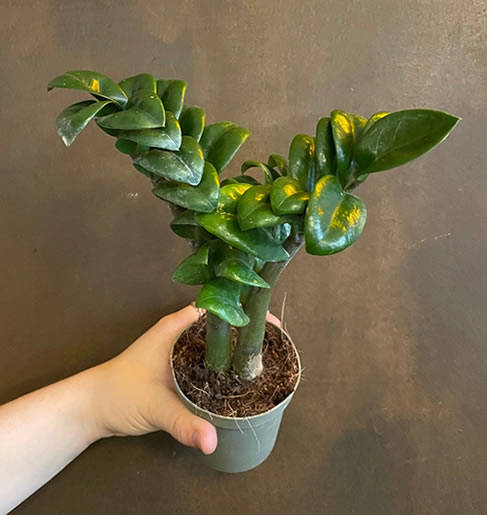
Whether you opt for the Raven ZZ, the classic Zanzibar Gem, or one of the other captivating ZZ varieties, the allure of these plants lies not only in their visual appeal but also in their tenacity.
The ZZ Plant family collectively thrives in conditions that might challenge other indoor greenery, making them a go-to choice for those seeking both beauty and resilience in their botanical companions.
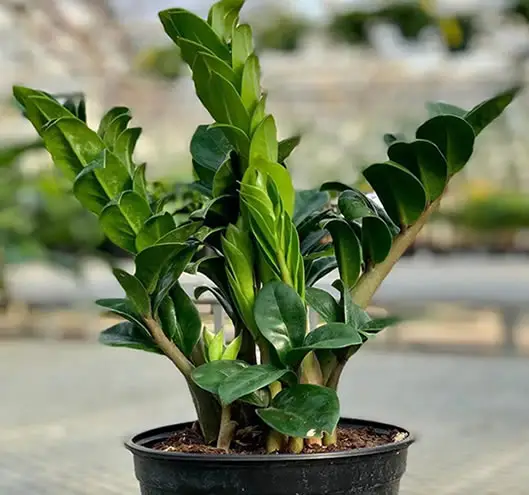
Below is a care guide for this botanical wonder. Stay with us as we unravel the mysteries and magic of the ZZ Plant.
ZZ Plant Care Guide
All varieties of the ZZ plant require the same basic care.
ZZ plant care falls into four different categories:
- Light requirements.
- Water needs.
- Temperature range.
- Ideal humidity range.
- Light requirements.
- Soil requirements & the best pot type.
Let’s look at each of these in detail.
ZZ plant light requirements
Light, the lifeblood of any plant, plays a pivotal role in the success of cultivating ZZ Plants.
One of the reasons behind the widespread popularity of Zamioculcas zamiifolia is its remarkable adaptability to varying light conditions, making it an ideal choice for both seasoned gardeners and those with less green-thumb experience.
ZZ Plants are renowned for their tolerance to low-light environments, making them well-suited for spaces with minimal natural sunlight.
While they can endure in shady corners or rooms with indirect light, ZZ Plants truly thrive when exposed to bright, indirect sunlight.
A spot near a north or east-facing window is often considered ideal, providing the plant with the necessary light to fuel its growth without subjecting it to harsh, direct rays.
Interestingly, ZZ Plants can also withstand conditions of neglect, making them an excellent choice for those who may not have the luxury of bathing their plants in sunlight daily.
This resilience extends to low-light office settings, making ZZ Plants a popular choice for bringing a touch of greenery to workspaces where natural light may be limited.
It’s worth noting that while ZZ Plants can survive in low-light conditions, they may grow more slowly compared to those receiving more abundant light.
As with any plant, balance is key, and finding the sweet spot that aligns with the specific needs of your ZZ Plant will ensure its longevity and continued vibrancy.
ZZ plant watering needs
The ZZ Plant’s reputation as a hardy and low-maintenance companion extends to its water requirements, adding to its allure as an indoor plant superstar.
Zamioculcas zamiifolia has evolved to endure periods of drought, storing water in its rhizomes, which act as reservoirs to sustain the plant during dry spells.
This unique adaptation makes ZZ Plants forgiving and well-suited for those who might not adhere to a strict watering schedule. Poor watering can lead to a host of problems (see our guide to identifying and treating ZZ plant problems).
Generally, ZZ Plants thrive in a drier environment and prefer to be on the “underwatered” side rather than overwatered.
A common mistake is to water ZZ Plants too frequently, which can lead to root rot—a condition the plant is surprisingly susceptible to if kept consistently moist.
As a rule of thumb, it’s advisable to let the top inch or two of the soil dry out between waterings.
This ensures that the plant has the opportunity to utilize its stored water reservoirs before receiving a fresh dose.
When it comes to the actual act of watering, ZZ Plants are quite accommodating.
They can be watered from the top, with water gently applied to the soil surface until it starts to seep out of the bottom drainage holes.
However, another method that aligns with the ZZ Plant’s natural inclinations is bottom watering.
By placing the pot in a saucer of water and allowing the plant to absorb moisture from below, you mimic the way ZZ Plants would receive water in their native habitats.
This method can help prevent overwatering, as the plant takes up only the water it needs.
The frequency of watering depends on various factors, including the environmental conditions, the size of the pot, and the season.
During the growing season (spring and summer), ZZ Plants may need more frequent watering, while in the dormant season (fall and winter), they require less.
Monitoring the soil’s moisture level and adjusting your watering routine accordingly is key to maintaining a happy and healthy ZZ Plant.
ZZ ideal temperature range
The ZZ Plant, with its origins in the warm and arid climates of Eastern Africa, is naturally adapted to thrive in a range of temperatures.
This adaptability to different temperature conditions makes it a resilient choice for indoor environments, where maintaining specific climate parameters can be a challenge.
Generally, ZZ Plants prefer temperatures that mimic their native habitat, thriving in the range of 65°F to 75°F (18°C to 24°C).
This temperature bracket is comfortable for most indoor spaces, ensuring that ZZ Plants can flourish without the need for excessive temperature control.
These plants can tolerate occasional temperature fluctuations, making them well-suited for homes and offices where heating and cooling may vary throughout the day. The ideal temperature for teh plant range falls nicely into the range experienced by the average US home.
During the winter months, ZZ Plants are generally content with temperatures slightly cooler than their optimal range, down to around 55°F (13°C).
However, it’s crucial to avoid exposing them to frost or extremely cold drafts, as these conditions can harm the plant.
While ZZ Plants are adaptable, they do have their limits. It’s advisable to steer clear of extremes—both hot and cold.
Avoid placing ZZ Plants in areas with temperatures consistently above 90°F (32°C) or below 45°F (7°C), as such extremes can stress the plant and impede its growth.
In essence, ZZ Plants are like the Goldilocks of the plant world when it comes to temperature—they prefer it not too hot, not too cold, but just right.
ZZ plant humidity requirements
The ZZ Plant, Zamioculcas zamiifolia, stands out not only for its resilience in various light and temperature conditions but also for its adaptability to humidity levels.
Originating from the arid regions of Eastern Africa, where humidity tends to be relatively low, the ZZ Plant has evolved to withstand a range of moisture conditions.
This makes it an excellent choice for indoor spaces with varying humidity levels.
ZZ Plants are well-suited for typical indoor humidity levels, which usually range between 40% and 60%.
They can tolerate lower humidity, such as that found in air-conditioned or heated environments, as well as higher humidity levels common in bathrooms.
This adaptability makes ZZ Plants versatile and suitable for placement in different areas of your home or office.
While ZZ Plants are not particularly demanding when it comes to humidity, there are a few considerations to keep in mind.
In dry indoor environments, especially during the winter months when heating systems are active, providing occasional misting or placing the plant on a humidity tray can offer a slight boost.
However, it’s essential not to create excessively damp conditions, as ZZ Plants are prone to root rot if the soil remains consistently soggy.
The key takeaway is that ZZ Plants are not finicky when it comes to humidity.
They can thrive in the ambient conditions typical of most indoor spaces, making them an excellent choice for individuals who may not have precise control over humidity levels.
In Summary: Unveiling the Resilient Beauty of ZZ Plants
The ZZ Plant, scientifically known as Zamioculcas zamiifolia, emerges as a resilient and low-maintenance marvel in the world of indoor gardening.
Originating from the arid regions of Eastern Africa, specifically Zanzibar, this adaptable beauty has earned monikers like Zanzibar Gem, Eternity Plant, and the striking Raven ZZ.
Notably, the ZZ Plant family showcases diverse varieties, each with its unique charm, from the dramatic foliage of the Raven ZZ to the compact elegance of the ZZ Zenzi.
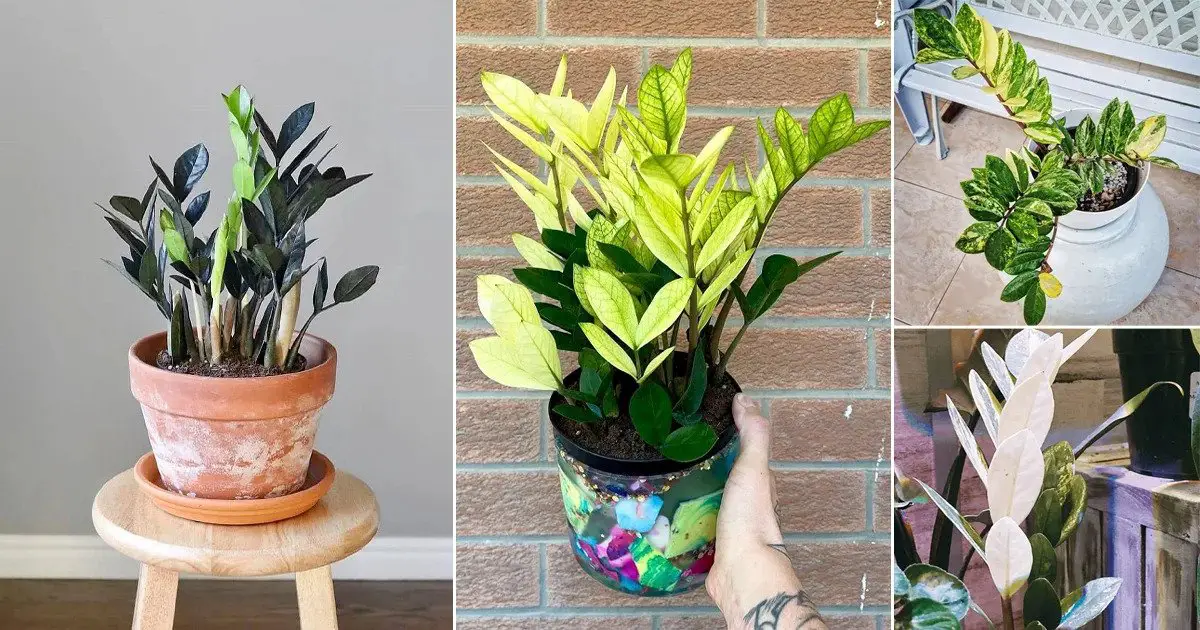
Thriving in a range of light conditions, ZZ Plants demonstrate remarkable resilience in low-light settings but truly shine in bright, indirect sunlight.
Their ability to endure neglect and adapt to varying light intensities makes them a go-to choice for both seasoned plant enthusiasts and novices.
Watering the ZZ Plant is a practice in balance—allowing the top layer of soil to dry before watering ensures the plant’s storage rhizomes are utilized effectively.
Whether watered from the top or bottom, ZZ Plants reward their caregivers with steady growth and minimal fuss.
Temperature-wise, ZZ Plants are content in the Goldilocks zone, flourishing in temperatures between 65°F to 75°F.
Their adaptability extends to slightly cooler conditions in the winter but calls for protection against frost.
As for humidity, the ZZ Plant’s hardiness shines through, tolerating a broad range of humidity levels typical in indoor environments.
From air-conditioned spaces to bathrooms, ZZ Plants showcase their resilience, thriving without demanding precise humidity control.
In essence, the ZZ Plant epitomizes the perfect blend of beauty and durability.
Its ability to adapt to various conditions, coupled with its striking aesthetics, makes it a prized addition to any indoor oasis.
Whether you’re a seasoned plant enthusiast or a beginner seeking a resilient green companion, the ZZ Plant stands ready to grace your space with elegance and ease.

